We use cookies to improve your experience and our business. See our privacy/cookie policy or continue browsing to accept our use of cookies. View our cookie policy.
What Kind of Chimney Do I Have For My Fire?
Unfortunately, it’s not always as simple as buying a new fire, installing it and then curling up in front of its nice warm glow. The style of fire you can have in your home will often be dictated by the type of chimney your home has.
If you’re new to the fireplace game or you’ve moved to a new house and you’re not sure what fire you can have in your home, it can be a little confusing. Here we will go through each type of chimney and tell you the types of fire you can have, whether that’s a gas or electric fire and the different types of each.
Guide to the Different Types of Flue...
Traditional chimneys (Class 1)
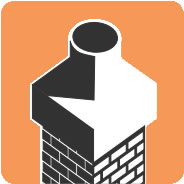 What are traditional chimneys?
What are traditional chimneys?
Well this one should be pretty obvious! These are the brick chimneys you get, mainly on older properties, that were to facilitate an open fire. They rely on the natural circulation of air to remove waste gases from the fireplace.
What fires can you have with a traditional chimney?
There are no major restrictions about the type of fire you can have with a traditional chimney, The internal diameter of the chimney will be 7 inches or more and so can cope with most things thrown at it.
Class 1 or 2 solid fuel fires, electric fires, gas fires, and gel fires are all suitable. Just remember that your fireplace chamber will need to be able to accommodate the fires. For example, an inset electric fire will need a different setup to a solid fuel fire.
Note: Over time, older chimneys may not be sealed and therefore may require a flue liner.
Take a look at our class 1 gas fires.
Prefabricated Flues (Class 2)
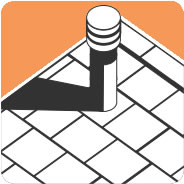 What is a prefabricated flue?
What is a prefabricated flue?
A prefabricated flue will either be used on older properties where a chimney has been lined with a steel flue, or a newer property with a steel flue built in. They are made up of interlocking metal flue pipes. You can easily identify a prefabricated flue by the metal cowl on the roof, which looks like a thin metal chimney.
What fires can you have with a prefabricated flue?
You can have electric, gas and gel fires with a prefabricated flue. They’re not equipped to deal with solid fuel fires. However, which specific fires you’re allowed generally comes down to the size of the flue.
Essentially, if your flue diameter is 7 inches, you’ll need a class 1 fire. For 5 inch flues, you’ll need a class 2 fire.
Take a look at our class 2 gas fires.
Pre-Cast Flues
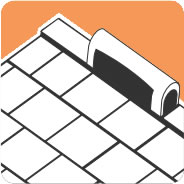 What is a pre-cast flue?
What is a pre-cast flue?
A pre-cast flue is built from concrete blocks and built into a property’s interior walls. They are a more common feature in new houses and can be recognised by a small ridge vent on the roof.
What fires can you have with a pre-cast flue?
Due to being much shallower than traditional chimneys and prefabricated flues, pre-cast flues are only compatible with class 2 fires.
Of course you can have an electric fire as well as they don’t require a chimney at all.
No Chimney
Some houses don’t have chimneys, but that doesn’t mean you can’t have a fire. Of course you can have an electric fire, and this is the option many choose if they don’t have a chimney, but technology has come a long way and there are also gas fires that work without a chimney. For example…
Flueless Gas Fires
Flueless gas fires, predictably, don’t require a flue at all. They work using a built-in catalytic converter to clean the fumes, and as no heat is lost through a flue, it also means they’re 100% efficient.
They do have a few fitting requirements, however. In order to install a flueless gas fire, you’ll need to install a 100cm2 ventilation brick on an external of that room. The room should also be around 25-30 cubic metres.
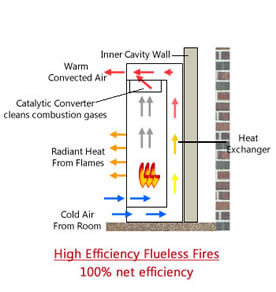
See all of our flueless gas fires.
Balanced Flue Gas Fires
Another option if you don’t have a chimney is a balanced flue gas fire, or a closed combustion gas fire as they’re also known. They need to be installed in a room with an external wall and use two pipes - one to extract fumes away from the fire, and one to draw in fresh air for combustion purposes. Balanced flue gas fires are usually 80-90% efficient.
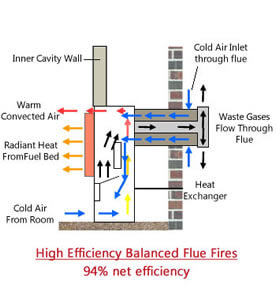
Below is a diagram of how the flue pipes can work for balanced flue and Powerflue gas fires.
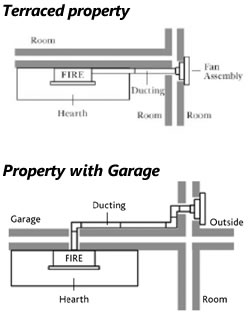
Powerflue Gas Fires
Powerflue gas fires extract fumes through the aid of a fan. A pipe leads from the fire which has a fan at the end - this means that in most cases they will need to be installed in a room with an external wall.
It’s important to note that powerflue gas fires also need an electricity supply to work.
See all of our balanced flue and Powerflue gas fires.
For more information on any of fires, please contact us.
[related_products is_auto_added="1"]direct fireplaces
Latest posts by direct fireplaces (see all)
- Which Electric Fireplace Gives the Most Heat? - February 5, 2021
- Retro Fires and Retro Stoves for the Home - January 22, 2021
- Do I Need a Fireplace in My New Home? - January 20, 2021








